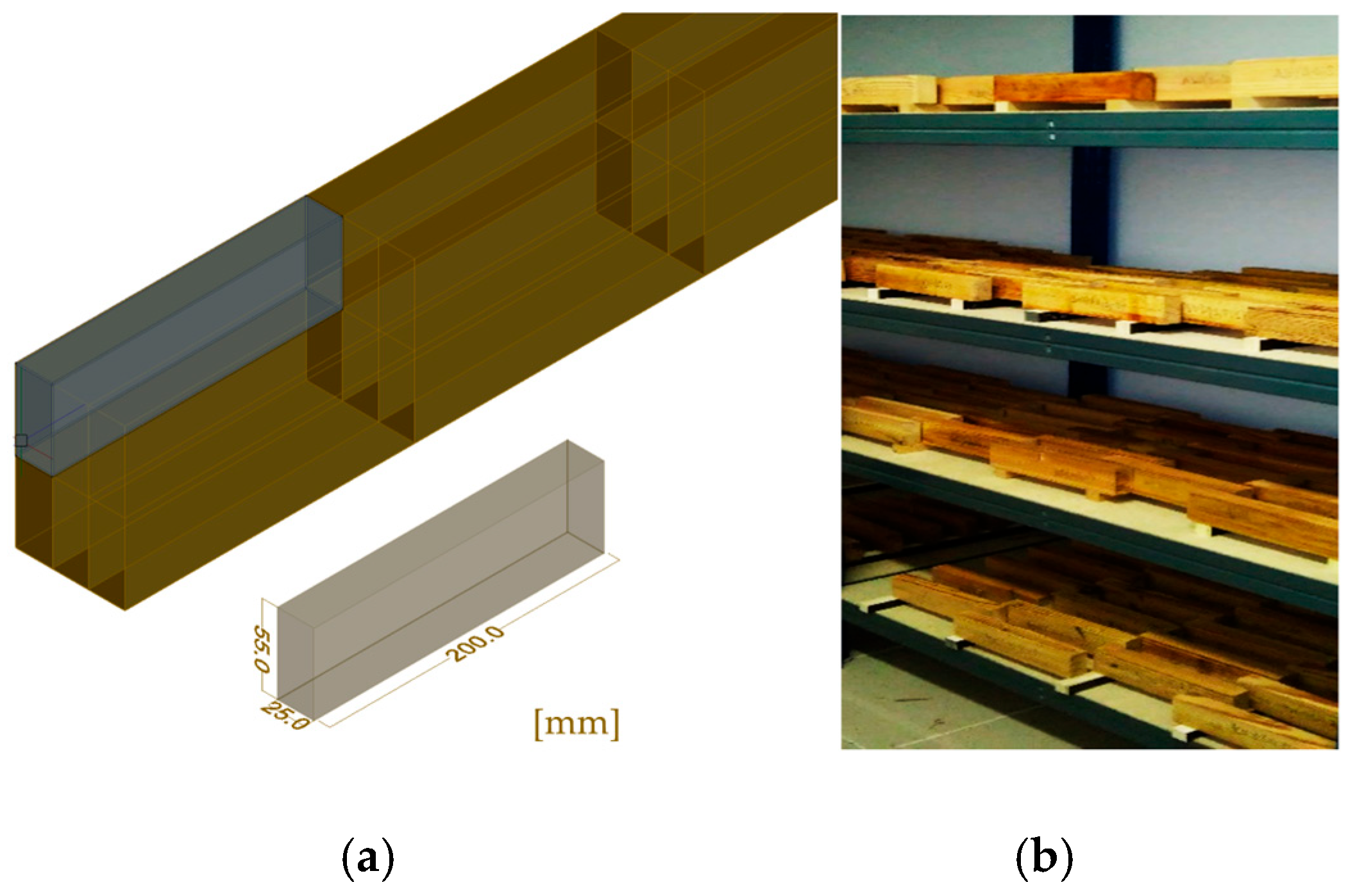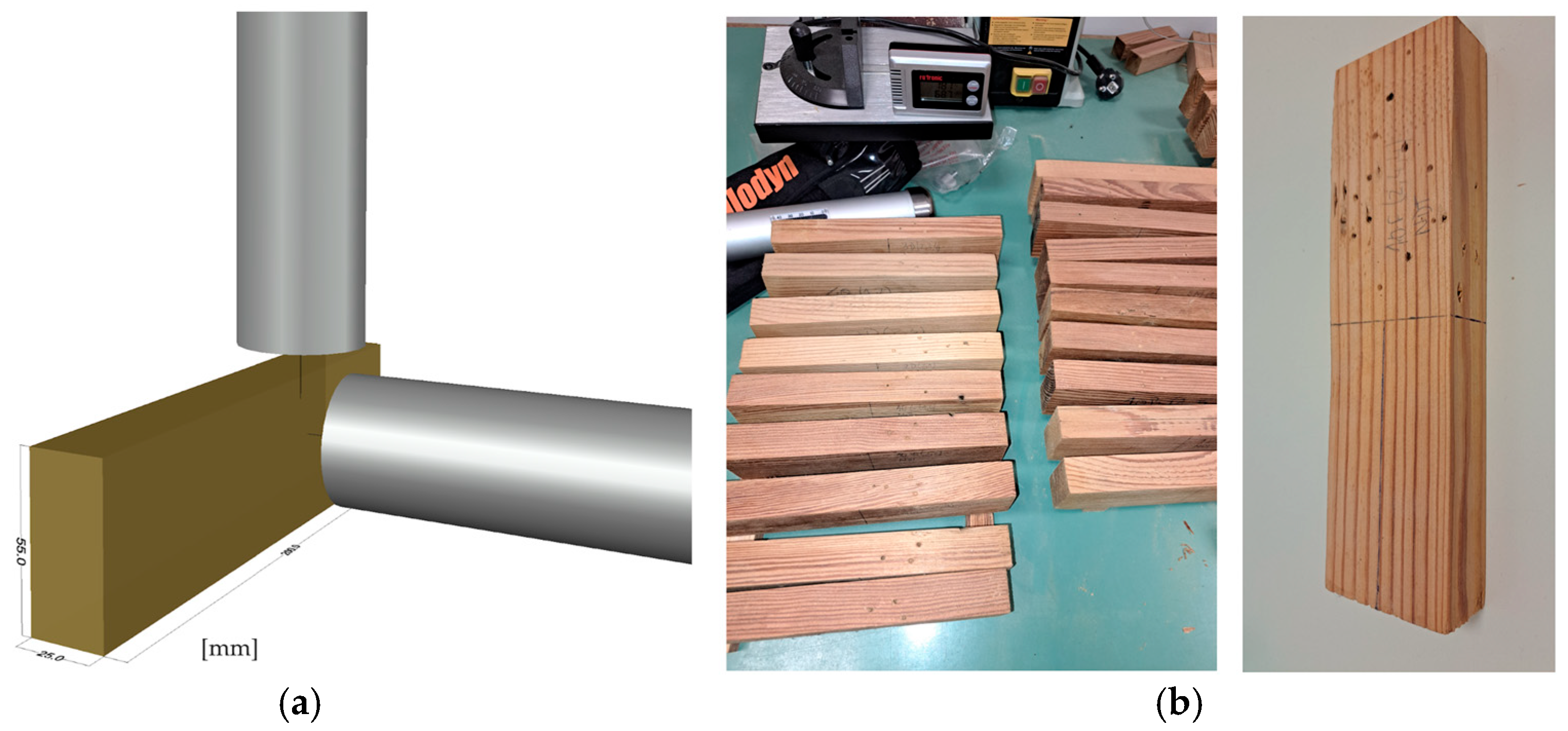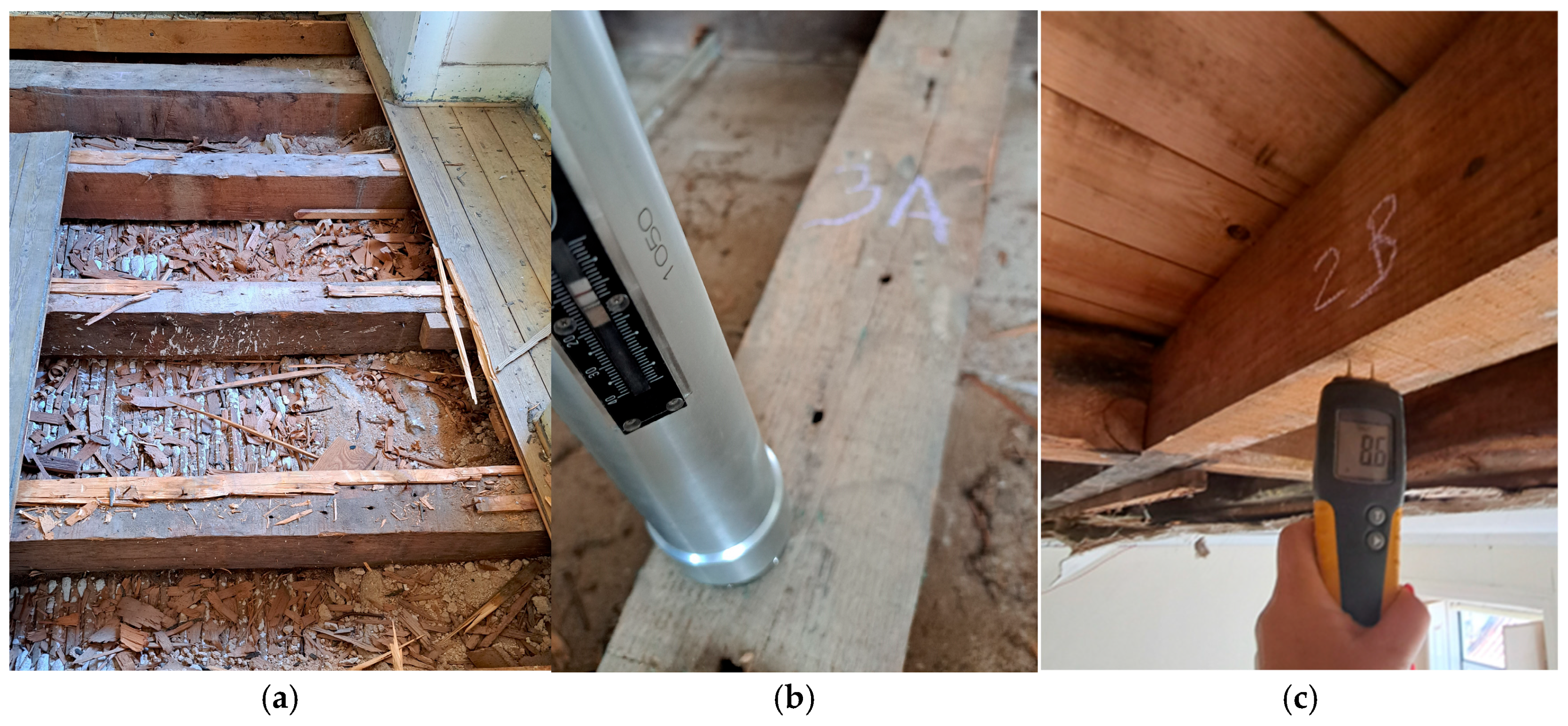Assessing the Density of Wood in Heritage Buildings’ Elements Through Expedited Semi-Destructive Techniques
Abstract
Featured Application
Abstract
1. Introduction
2. Materials and Methods
2.1. Materials
2.2. Determination of the Air-Dry Density
2.3. Laboratory-Phase Needle Penetration Tests
2.4. In Situ Moisture Content Determination, Needle Penetration, and Core Drilling
- Determination of the wooden elements’ moisture contents as well as the relative humidity and temperature values of the building during the days of the inspections (Figure 4);
- Visual inspection of the geometric dimensions and conservation state of structural elements (Figure 4);
- Estimation of the density of structural elements with NPR testing in situ (Figure 4);
- Core drilling of structural elements in situ to obtain the measured density after conditioning (Figure 5).
2.5. In Situ Density Estimation
2.6. Statistical Tests
3. Results and Discussion
3.1. Correlation Between Needle Penetration and the Air-Dry Density
3.2. Penetration Resistance and Effect of the Moisture Content
3.3. Estimation of the Wood Density In Situ
- -
- is the estimated density (kg/m3) of reading i;
- -
- NPi,corrected is the reading i of the needle penetration tests, corrected by Equation (1) (mm).
- -
- is the estimated density (kg/m3) of in situ reading I;
- -
- NPi,in-situ is the in situ reading i of the needle penetration tests (mm);
- -
- Δu (%) is the moisture content difference (%) between the in situ and reference (12%) moisture contents.
4. Conclusions
Author Contributions
Funding
Data Availability Statement
Acknowledgments
Conflicts of Interest
References
- Thieme, H. Lower Palaeolithic Hunting Spears from Germany. Nature 1997, 385, 807–810. [Google Scholar] [CrossRef] [PubMed]
- Pulak, C. The Uluburun Shipwreck: An Overview. Int. J. Naut. Archaeol. 1998, 27, 188–224. [Google Scholar] [CrossRef]
- Christie, H.; Olsen, O.; Taylor, H.M. The Wooden Church of St. Andrew at Greensted, Essex. Antiqu. J. 1979, 59, 92–112. [Google Scholar] [CrossRef]
- Tsoumis, G. Science and Technology of Wood: Structure, Properties, Utilization; Van Nostrand Reinhold: New York, NY, USA, 1991; Volume 115. [Google Scholar]
- Fengel, D.; Wegener, G. Wood: Chemistry, Ultrastructure Reactions; Walter de Gruyter: Berlin, Germany, 1984. [Google Scholar]
- Henriques, D.F.; Nunes, L.; Machado, J.S.; de Brito, J. Timber in Buildings: Estimation of Some Properties Using Pilodyn and Resistograph. In Proceedings of the International Conference on Durability of Building Materials and Components, Porto, Portugal, 12–15 April 2011; pp. 12–15. [Google Scholar]
- Kloiber, M.; Tippner, J.; Hrivnák, J. Mechanical Properties of Wood Examined by Semi-Destructive Devices. Mater. Struct. 2014, 47, 199–212. [Google Scholar] [CrossRef]
- Brunetti, M.; Aminti, G.; Vicario, M.; Nocetti, M. Density Estimation by Drilling Resistance Technique to Determine the Dynamic Modulus of Elasticity of Wooden Members in Historic Structures. Forests 2023, 14, 1107. [Google Scholar] [CrossRef]
- DIN 52182:1976; Testing of Wood—Determination of Density. Deutsches Institut für Normung: Berlin, Germany, 1976.
- ISO 13061-2:2014; Wood—Determination of Density. International Organization for Standardization: Geneva, Switzerland, 2014.
- EN 384:2016; Structural Timber—Determination of Characteristic Values of Mechanical Properties and Density. European Committee for Standardization: Brussels, Belgium, 2016.
- Feio, A.; Machado, J.S. In-Situ Assessment of Timber Structural Members: Combining Information from Visual Strength Grading and NDT/SDT Methods–A Review. Constr. Build. Mater. 2015, 101, 1157–1165. [Google Scholar] [CrossRef]
- Henriques, D.F.; Neves, A.S. Semi-Destructive in Situ Tests as Support to the Assessment of a Conservation Process. Constr. Build. Mater. 2015, 101, 1253–1258. [Google Scholar] [CrossRef]
- Llana, D.F.; Íñiguez-González, G.; Montón, J.; Arriaga, F. In-Situ Density Estimation by Four Nondestructive Techniques on Norway Spruce from Built-in Wood Structures. Holzforschung 2018, 72, 871–879. [Google Scholar] [CrossRef]
- Nowak, T.P.; Jasieńko, J.; Hamrol-Bielecka, K. In Situ Assessment of Structural Timber Using the Resistance Drilling Method–Evaluation of Usefulness. Constr. Build. Mater. 2016, 102, 403–415. [Google Scholar] [CrossRef]
- Henriques, D.F.; Clara, M.; Flores-Colen, I. Condition Assessment of Timber in the Old Built Heritage-a Case Study. Proced. Struct. Integr. 2024, 55, 214–221. [Google Scholar] [CrossRef]
- Cavalli, A.; Togni, M. How to Improve the On-Site MOE Assessment of Old Timber Beams Combining NDT and Visual Strength Grading. Nondestruct. Test. Eval. 2013, 28, 252–262. [Google Scholar] [CrossRef]
- Niemz, P.; Mannes, D. Non-Destructive Testing of Wood and Wood-Based Materials. J. Cult. Herit. 2012, 13, S26–S34. [Google Scholar] [CrossRef]
- Ponneth, D.; Vasu, A.E.; Easwaran, J.C.; Mohandass, A.; Chauhan, S.S. Destructive and Non-Destructive Evaluation of Seven Hardwoods and Analysis of Data Correlation. Holzforschung 2014, 68, 951–956. [Google Scholar] [CrossRef]
- Chen, Z.-Q.; Karlsson, B.; Lundqvist, S.-O.; García Gil, M.R.; Olsson, L.; Wu, H.X. Estimating Solid Wood Properties Using Pilodyn and Acoustic Velocity on Standing Trees of Norway Spruce. Ann. For. Sci. 2015, 72, 499–508. [Google Scholar] [CrossRef]
- Greaves, B.L.; Borralho, N.M.G.; Raymond, C.A.; Farrington, A. Use of a Pilodyn for the Indirect Selection of Basic Density in Eucalyptus Nitens. Can. J. For. Res. 1996, 26, 1643–1650. [Google Scholar] [CrossRef]
- Bucur, V. Ultrasonic, Hardness and x-Ray Densitometric Analysis of Wood. Ultrasonics 1985, 23, 269–275. [Google Scholar] [CrossRef]
- Villasante, A.; Íñiguez-González, G.; Puigdomenech, L. Comparison of Various Multivariate Models to Estimate Structural Properties by Means of Non-Destructive Techniques (NDTs) in Pinus sylvestris L. Timber. Holzforschung 2019, 73, 331–338. [Google Scholar] [CrossRef]
- Freyburger, C.; Longuetaud, F.; Mothe, F.; Constant, T.; Leban, J.-M. Measuring Wood Density by Means of X-Ray Computer Tomography. Ann. For. Sci. 2009, 66, 804. [Google Scholar] [CrossRef]
- Mannes, D.; Josic, L.; Lehmann, E.; Niemz, P. Neutron Attenuation Coefficients for Non-Invasive Quantification of Wood Properties. Holzforschung 2009, 63, 472–478. [Google Scholar] [CrossRef]
- Xin, Z.; Guan, C.; Zhang, H.; Yu, Y.; Liu, F.; Zhou, L.; Shen, Y. Assessing the Density and Mechanical Properties of Ancient Timber Members Based on the Active Infrared Thermography. Constr. Build. Mater. 2021, 304, 124614. [Google Scholar] [CrossRef]
- Guillermo, I.-G.; Joaquín, M.; Francisco, A.; Edgar, S. In-Situ Assesment of Structural Timber Density Using Non-Destructive and Semi-Destructive Testing. Bioresources 2015, 10, 2256–2265. [Google Scholar] [CrossRef]
- Ek, M.; Gellerstedt, G.; Henriksson, G. Wood Chemistry and Wood Biotechnology; Walter de Gruyter: Berlin, Germany, 2009; ISBN 3110213397. [Google Scholar]
- Pizzo, B.; Macchioni, N.; Capretti, C.; Pecoraro, E.; Sozzi, L.; Fiorentino, L. Assessing the Wood Compressive Strength in Pile Foundations in Relation to Diagnostic Analysis: The Example of the Church of Santa Maria Maggiore, Venice. Constr. Build. Mater. 2016, 114, 470–480. [Google Scholar] [CrossRef]
- Llana, D.F.; Hermoso, E.; Bobadilla, I.; Iñiguez-Gonzalez, G. Influence of Moisture Content on the Results of Penetration and Withdrawal Resistance Measurements on Softwoods. Holzforschung 2018, 72, 549–555. [Google Scholar] [CrossRef]
- Llana, D.F.; Íñiguez-González, G.; Esteban, M.; Hermoso, E.; Arriaga, F. Timber Moisture Content Adjustment Factors for Nondestructive Testing (NDT): Acoustic, Vibration and Probing Techniques. Holzforschung 2020, 74, 817–827. [Google Scholar] [CrossRef]
- Fernández Llana, D.; Hermoso Prieto, E.; Izquierdo García, S.T.; Bobadilla Maldonado, I.; Iñiguez Gonzalez, G. The Effect of Moisture Content on Nondestructive Probing Measurements. In Proceedings of the 9th International Nondestructive Testing and Evaluation of Wood Symposium, Río de Janeiro, Brazil, 22–25 September 2015; pp. 187–191. [Google Scholar]
- Maldonado, I.B.; Herrero, M.E.; Gonzalez, G.I.; Martitegui, F.A.; Montesinos, D.B.; Monteagudo, J.P. Density Estimation by Screw Withdrawal Resistance and Probing in Structural Sawn Coniferous Timber, and Modulus of Elasticity Assessment. Inf. Construcción 2007, 59, 107–116. [Google Scholar] [CrossRef]
- Arriaga, F.; Osuna-Sequera, C.; Esteban, M.; Iniguez-Gonzalez, G.; Bobadilla, I. In Situ Assessment of the Timber Structure of an 18th Century Building in Madrid, Spain. Constr. Build. Mater. 2021, 304, 124466. [Google Scholar] [CrossRef]
- Iñiguez, G. Clasificación Mediante Técnicas No Destructivas y Evaluación de Las Propiedades Mecánicas de La Madera Aserrada de Coníferas de Gran Escuadría Para Uso Estructural. (Grading by Nondestructive Techniques and Evaluation of Mechanical Properties of Large Cross-Section Coniferous Timber for Structural Use). Ph.D. Thesis, ETS de Ingenieros de Montes, Universidad Politécnica de Madrid, Madrid, Spain, 2007; p. 223. [Google Scholar]
- EN 1995-1-1:2004; Eurocode 5: Design of Timber Structures—Part 1-1: General—Common Rules and Rules for Buildings. European Committee for Standardization: Brussels, Belgium, 2004.
- Kollmann, F.F.P.; Côté, W.A. Physics of Wood. In Principles of Wood Science and Technology: I Solid Wood; Springer: Syracuse, NY, USA, 1968; pp. 160–291. [Google Scholar]
- Görlacher, R. Zerstörungsfreie Prüfung von Holz: Ein „in Situ”-Verfahren Zur Bestimmung Der Rohdichte. Holz Als Roh-und Werkst. 1987, 45, 273–278. [Google Scholar] [CrossRef]
- Branco, J.M.; Piazza, M.; Cruz, P.J.S. Structural Analysis of Two King-Post Timber Trusses: Non-Destructive Evaluation and Load-Carrying Tests. Constr. Build. Mater. 2010, 24, 371–383. [Google Scholar] [CrossRef]
- Notivol, E.; Gil, L.A.; Pardos, J.A. Wood Specific Gravity and Variability Estimation in Pinus Pinaster Ait, Trees. For. Syst. 1992, 1, 41–47. [Google Scholar] [CrossRef]
- Feio, A.O. Inspection and Diagnosis of Historical Timber Structures: NDT Correlations and Structural Behaviour. Ph.D. Thesis, University of Minho, Braga, Portugal, 2006. [Google Scholar]
- Simpson, W.T. Drying and Control of Moisture Content and Dimensional Changes. In Wood Handbook: Wood as An Engineering Material; General Technical Report FPL; GTR-113; USDA Forest Service, Forest Products Laboratory: Madison, WI, USA, 1999; Volume 113, pp. 12.1–12.20. [Google Scholar]
- As, N.; Goker, Y.; Dundar, T. Effect of Knots on the Physical and Mechanical Properties of Scots Pine. Wood Res. 2006, 51, 51–58. [Google Scholar]
- Bektas, I.; Alma, M.H.; As, N. The Effect of 120 Years of Service on Various Physical and Mechanical Properties of Scots Pine Wood Used as Roof Beam. Wood Res.-Slovak. 2005, 50, 27–32. [Google Scholar]
- Hannrup, B.; Danell, Ö.; Ekberg, I.; Moëll, M. Relationships between Wood Density and Tracheid Dimensions in Pinus sylvestris L. Wood Fiber Sci. 2001, 33, 173–181. [Google Scholar]








| Beam Code | Dimensions (m) | Number of Specimens (25 × 55 × 200 mm) | ||
|---|---|---|---|---|
| Section | Length | Total | Suitable for Test | |
| 10A | 0.11 × 0.14 | 1.52 | 24 | 13 |
| 10C | 0.14 × 0.15 | 1.40 | 48 | 24 |
| 10E | 0.15 × 0.15 | 1.48 | 48 | 8 |
| 10F | 0.14 × 0.15 | 1.49 | 49 | 11 |
| 3D | 0.12 × 0.13 | 1.50 | 20 | 12 |
| Total | 189 | 68 | ||
| Building | Original Construction From | Location |
|---|---|---|
| A | Last quarter of the 18th century | Historical center of Lisbon |
| B | Middle of the 19th century | Outskirts of Lisbon |
| C | Last quarter of the 19th century | Historical center of Lisbon |
| D | The 1940s of the 20th century | Outskirts of Lisbon |
| Identification | Moisture Content (u) In Situ (%) | NPR Testing | Wood Density (kg/m3) | ||||
|---|---|---|---|---|---|---|---|
| Number of Readings In Situ | Penetration Depth (mm) | Density Estimated by Equation (4) | Core Drilling (Measured Density at u = 12%) | Difference Between Estimated and Measured Density (%) | |||
| In Situ | Corrected to 12% u * by Equation (1) | ||||||
| A—building from the 18th century’s last quarter—historical center of Lisbon | |||||||
| A1 | 10.1 | 5 | 12.8 ± 0.8 | 13.2 | 509 | 545 | 6.6 |
| A2 | 10.3 | 5 | 13.3 ± 0.8 | 13.6 | 498 | 481 | 3.5 |
| A3 | 9.8 | 5 | 12.7 ± 1.0 | 13.1 | 510 | 559 | 8.8 |
| A4 | 11.3 | 5 | 12.0 ± 0.5 | 12.1 | 534 | 572 | 6.7 |
| A5 | 10.8 | 5 | 13.5 ± 2.3 | 13.7 | 495 | 477 | 3.9 |
| A6 | 11.2 | 5 | 13.2 ± 0.3 | 13.4 | 505 | 487 | 3.6 |
| B—building from the mid-19th century—outskirts of Lisbon | |||||||
| B1 | 12.1 | 5 | 12.5 ± 0.5 | 12.5 | 525 | 541 | 2.9 |
| B2 | 11.1 | 5 | 13.3 ± 0.5 | 13.5 | 502 | 499 | 0.5 |
| C—building from the 19th century’s last quarter—historical center of Lisbon | |||||||
| C1 | 9.0 | 5 | 17.2 ± 1.9 | 18.0 | 395 | 387 | 2.2 |
| C2 | 8.6 | 7 | 11.1 ± 0.9 | 11.7 | 544 | 560 | 2.9 |
| C3 | 10.8 | 7 | 13.5 ± 1.5 | 13.7 | 495 | 470 | 5.4 |
| C4 | 10.4 | 5 | 10.7 ± 1.0 | 11.0 | 561 | 645 | 13.0 |
| D—building from the 1940s of the 20th century—outskirts of Lisbon | |||||||
| D1 | 12.6 | 4 | 13.2 ± 1.1 | 13.1 | Ne ** | 421 | - |
| D2 | 11.7 | 4 | 11.3 ± 0.5 | 11.4 | 552 | 558 | 1.1 |
| D3 | 12.5 | 4 | 12.8 ± 0.8 | 12.7 | 520 | 511 | 1.8 |
| D4 | 12.3 | 4 | 16.0 ± 1.0 | 15.9 | 444 | 426 | 4.3 |
| D5 | 11.4 | 4 | 13.5 ± 1.3 | 13.6 | 498 | 509 | 2.1 |
| D6 | 12.1 | 4 | 12.8 ± 1.2 | 12.8 | 518 | 480 | 8.0 |
| Average | 506 | 512 | 4.6 | ||||
| Std | 38 | 61 | 3.2 | ||||
| Relative RMSE (%) | 5.6 | ||||||
| Normalized RMSE (%) | 11.7 | ||||||
Disclaimer/Publisher’s Note: The statements, opinions and data contained in all publications are solely those of the individual author(s) and contributor(s) and not of MDPI and/or the editor(s). MDPI and/or the editor(s) disclaim responsibility for any injury to people or property resulting from any ideas, methods, instructions or products referred to in the content. |
© 2025 by the authors. Licensee MDPI, Basel, Switzerland. This article is an open access article distributed under the terms and conditions of the Creative Commons Attribution (CC BY) license (https://creativecommons.org/licenses/by/4.0/).
Share and Cite
Henriques, D.F.; Șen, A.U.; Gomes, M.d.G. Assessing the Density of Wood in Heritage Buildings’ Elements Through Expedited Semi-Destructive Techniques. Appl. Sci. 2025, 15, 7552. https://doi.org/10.3390/app15137552
Henriques DF, Șen AU, Gomes MdG. Assessing the Density of Wood in Heritage Buildings’ Elements Through Expedited Semi-Destructive Techniques. Applied Sciences. 2025; 15(13):7552. https://doi.org/10.3390/app15137552
Chicago/Turabian StyleHenriques, Dulce F., Ali Umut Șen, and Maria da Glória Gomes. 2025. "Assessing the Density of Wood in Heritage Buildings’ Elements Through Expedited Semi-Destructive Techniques" Applied Sciences 15, no. 13: 7552. https://doi.org/10.3390/app15137552
APA StyleHenriques, D. F., Șen, A. U., & Gomes, M. d. G. (2025). Assessing the Density of Wood in Heritage Buildings’ Elements Through Expedited Semi-Destructive Techniques. Applied Sciences, 15(13), 7552. https://doi.org/10.3390/app15137552








